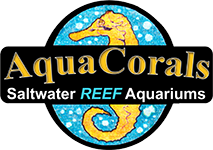How to Setup an AquaCorals Reef Tank  Steps to Setup
Steps to Setup
 Steps to Setup
Steps to Setup
Steps to Setup your AquaCorals Reef System
1. Place your tank in the spot you want it. Tanks over 90 gallons should be placed so it sits across multiple floor stringers for better support. Exterior or supported interior walls are an even better placement choice! Make sure it sits level!
2. Add your dry substrate: For those of you wishing to "jump start" your bio system with live sand, add your dry sand now & wait until step 5 to add the live. It is highly recommended that you rinse your dry sand before adding to the tank. Using a 5g pail or other container, fill 1/2 way with sand then fill with fresh water & let the water overflow the container. Stir the sand while the water is running. This allows the "dust" material to overflow with the water while the heavier sand stays on the bottom. Rinse until the water looks like watered down milk. Do not wait until the water to runs clear! Would take forever! ;) Pour off as much water as you can then dump the sand into the tank. Add your fine sand first (Aragamax) then heavier sand on top (Sea Flor).
3. Setup your overflow system - Overflow box sets to dump to your sump
Plumb Your Pump System - PVC from your pump into your tank
Pump Plumbing Parts Diagram
How To Drill A Siphon Break Hole - Coming Soon!
4. Add your water & salt (to mix a “specific gravity” of 1.026 - understanding that most salts elements are formulated to this salinity), install power heads & heater set to 78 degrees (in sump - don't turn it on until you have water in the sump & are ready to start the system!) . The power heads should consist of one back wall to front & 2 more on both tank ends for 4 ft tanks & 2 on the back tank wall for 6 ft tanks, flows facing front 1/3 in to the tank front center. Prime your overflow set, turn on your main pump & start your system. Let your system water mix for at least 24 hours then…
5. Add your Live Sand & Rock. For those of you wishing to "jump start" your bio system with live sand, this is the time to add it. Do Not rinse your live sand! Once all sand is installed you can then begin placement of your live rock. Make sure your rock structure is solid (won’t fall down) with an open channel behind and spaces between the rocks for good water circulation. "Screw" or "twist" down the first base rocks into the sand to secure then build up. Again, leave a 1 - 2 inch space behind the rocks and leave yourself room to be able to scrape the glass where you want to view. Be sure to run your skimmer!
6. Patience! Allow at least 4 weeks for the tank to “cycle”. Caution! This is where many hobbyists get impatient & get into trouble! There is no "quick fix" to the cycle. It takes time for "all good bacteria types" to grow in enough numbers to break down all wastes in the system. Failure to be patient at this time will inevitably result in livestock death & money flushed down the drain!
7. Add “Clean Up Crew”. Cucumbers & Nassarius snails (clean sand) Astrea or Turbo snails (eat algae) Sm. Brittle Starfish (eat fish waste and uneaten fish food. Adding Hermit Crabs of any kind is not recommended. Even Scarlet Reef Hermits will make a meal of Astrea snails. Hermits will irritate the snail’s foot until it let’s go of what it’s attached to then the hermit will pick at the snails until the snail is devoured. Again, there are other critters without "bad behaviors" to use for clean up. See "Inverts & Clean Up Crew" for how many I recommend to add to a tank of each & more detailed information about each.
Please! Do not cycle your tank with a fish (Damsels, Mollies or otherwise). The Ammonia & NitrItes created by the cycle will kill or at the very least, torture these fish!! Again, please Do Not Use Fish to Cycle Your Tank! The live sand will be enough to cycle a new tank. Though pretty, Damsels are super territorial & will chase & pick on any new fish added after. For any newly Introduced fish, being harassed by a Damsel is extremely stressful and many times results in death of the newcomer. I DO NOT SELL DAMSELS nor do I advise anyone to buy them for this reason. Select your fish carefully. Will they eat corals? Will they get along with the other fish you have or may like to add in the future? Will they eat inverts (shrimp, feather dusters etc.)?
I highly recommend beginners to read my short message "Tips For Beginners". Please, research &/or ask before you buy! E-mail with me any questions. I want you to be successful & am more than happy to help you!